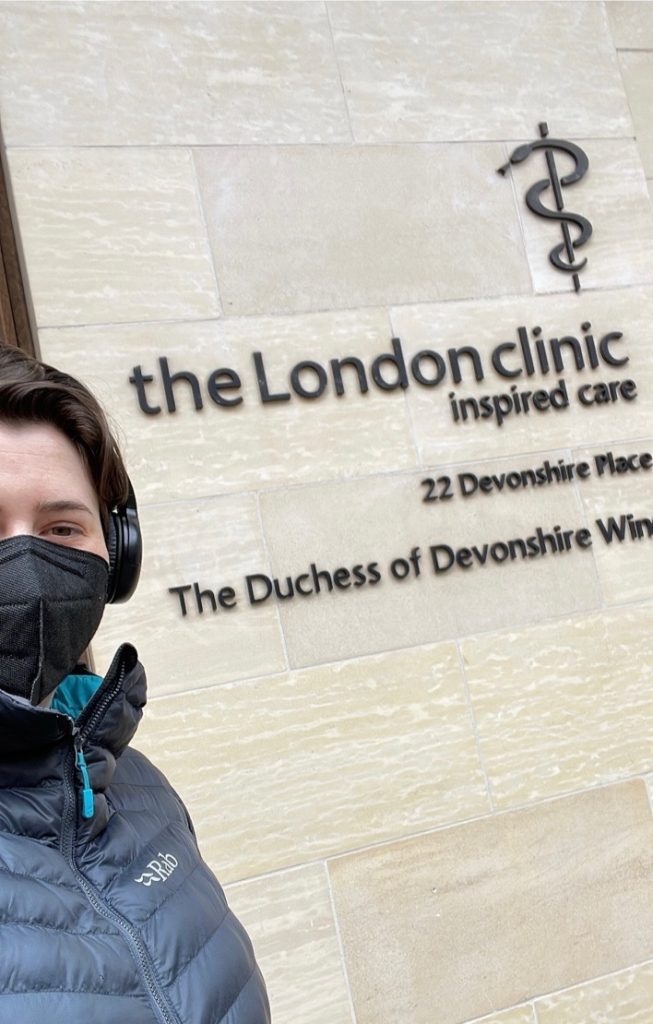Every 14 minutes, someone is diagnosed with blood cancer. Anthony Nolan is the charity that makes lifesaving connections between patients in need and individuals who are willing to donate their stem cells. As well as connecting patients and donors, the charity also funds research that could transform the future for more patients. Earlier this year, our admin assistant Phoebe was contacted by Anthony Nolan to donate lymphocytes towards this research.
We thought it would be a great opportunity to share Phoebe’s experience, while also sharing information about blood cancer and blood disorders. [There are a couple of photos of Phoebe’s donation experience, including one showing the cannula.]
The Donation Process
I signed up to the Anthony Nolan register when I was in 1st year of university, in 2016. I remember that there was a tent at the Freshers’ Week fair and all you had to do was donate a saliva sample and fill out a form. I had initially been a bit nervous, because I associated stem cell donation with a surgical procedure, but was very surprised to find out that 90% of donors donate through PBSC (peripheral blood stem cell collection). This is a simple, outpatient procedure similar to giving blood. The whole thing took less than 5 minutes, and then I didn’t hear from AN until April 2023.

One afternoon in early April, I received a call from the donor team, explaining that they were interested in my HLA type for research – HLA is a type of molecule found on the surface of most cells in the body that helps your immune system. As they had my information on their database from that 2016 swab, the research team were able to identify that I was eligible to contribute to an Oxford University study looking at both the discovery and T-cell targeting of antigens that would be considered non-self and expressed in sarcoma.
I spoke to the donor team on the phone for around 30 minutes, where they explained that if I was happy to donate lymphocytes I would be invited for a medical assessment. If that was clear, I would donate by running my blood through a centrifuge which would extract the lymphocytes. I was more than happy to do so, as I have given blood before and was more than happy to undergo a similar process in order to contribute to potentially life-saving research.
I travelled to London in April for my medical, where I met the medical team at The London Clinic and had bloods taken, along with an ECG, my blood pressure and physical examination. The results of my tests were all clear, so I was invited back in May to donate. This process could not have been more straightforward.

I arrived at the Clinic at 8:30, met the nursing team and was very well looked after. I was in a quiet ward with one other individual donating for Anthony Nolan, and I was able to fully move one of my arms the whole time so I was very comfortable. The whole process took around 5 hours from start to finish. The team had explained that the anti-coagulant solution they use in the centrifuge may bind with the calcium in my blood, meaning that it didn’t come back into my body and so the only real “hiccup” was that (as expected) this happened and I was given some supplementary calcium.
Once I finished, I was given lunch at the hospital and travelled back to Scotland.
Why is this important? Blood Cancers
As you know, our blood is made up of different cell types including red blood cells for carrying oxygen, platelets to help blood clot and white blood cells that fight infections.
They all originally come from stem cells, which have the potential to develop into any type of blood cell as they divide and mature. Problems in this process, known as ‘differentiation’, are at the root of all blood cancers. Different types of blood cancer depend on when and how these problems occur.
These problems often lead to your body producing large numbers of immature blood cells that can’t perform their job properly. They can also ‘clog up’ your bone marrow, which prevents other types of blood cells from doing their job too.
Blood cancers are categorised into three groups – leukaemia, lymphoma, and myeloma.
- About 2,300 people in the UK need a stem cell transplant from a stranger every year
- Blood cancer is the fifth most common type of cancer in the UK and the third biggest cancer killer. It accounts for 9% of all new cases of cancer diagnosed in the UK.
Depending on the type of blood cancer, there are different treatment pathways. Each of these comes with its own side effects, which are taught as part of our Level 4 CanRehab Specialist Instructor course. In order to learn more about these cancers, as well as how you can safely work with people with cancer, visit our website or email CanRehab for more information at info@canrehab.co.uk
If you’re interested in learning more about Anthony Nolan and their work, or the study that Phoebe contributed to please visit their website or get in touch with us at admin@canrehab.co.uk
